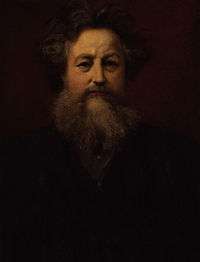Society for the Protection of Ancient Buildings
The Society for the Protection of Ancient Buildings (SPAB) (sometimes known as Anti-Scrape[1]) is an amenity society founded by William Morris, Philip Webb and others, in 1877; to oppose what they saw as destructive 'restoration' of ancient buildings then occurring in Victorian England; 'ancient' being used in the wider sense of 'very old' rather than the more usual modern one of 'pre-medieval'.
Morris was particularly concerned about the practice, which he described as 'forgery', of attempting to return functioning buildings to an idealised state from the distant past, which often involved the removal of elements added in their later development, and which Morris saw as contributing to their interest as documents of the past. Instead, he proposed that ancient buildings should be repaired, not restored, so that their entire history would be protected as cultural heritage. Today, these principles are widely accepted.

The architect A. R. Powys served as the Secretary of the SPAB for 25 years in the early 20th century.[2]
Organisation and activities
Today, the SPAB still operates according to Morris's original manifesto. It campaigns, advises, runs training programmes and courses, conducts research and publishes information. As one of the National Amenity Societies, the Society is a statutory consultee on alterations to listed buildings, and by law must be notified of any application in England and Wales to demolish in whole or part any listed building.[3] It currently has c. 8,500 members (2012). The Society also has a branch in Scotland.
The society, which is a registered charity, is based at 37 Spital Square, London.
For its dedicated service to heritage, the society was awarded the European Union Prize for Cultural Heritage / Europa Nostra Award in 2012.[4][5][6]
Mills
The society's Mills Section is the only British national body concerned with the protection, repair and continued use of traditional windmills and watermills; Ken Major carried out much work on its behalf.
Places of worship
An annual award honours the memory of church enthusiast and SPAB member Sir John Betjeman and is made for outstanding repairs to the fabric of places of worship in England and Wales completed in the last 18 months.[7]
See also
References
- Thompson, E. P. (1976). William Morris: Romantic to Revolutionary. New York: Pantheon. p. 228. ISBN 0-394-73320-7.
The Society, which Morris dubbed "Anti-Scrape...
- Ltd, e3 Media. "From the ground up. collected papers of A.R. Powys, architect, writer, and Secretary of the Society for the Protection of Ancient Buildings, 1882-1936. With an introduction by John Cowper Powys and two photographs. 3178155". www.nationaltrustcollections.org.uk. Retrieved 27 December 2018.
- Department for Communities and Local Government (24 March 2015), "Arrangements for handling heritage applications Direction 2015", www.GOV.uk, HM Government, retrieved 27 February 2017
- "2012 EU Prize for Cultural Heritage / Europa Nostra Awards – Category 3 - Dedicated service". EuropaNostra.org. Europa Nostra. Retrieved 27 February 2017.
- "The Society for the Protection of Ancient Buildings (SPAB)". EuropaNostra.org. Europa Nostra. 20 March 2012. Retrieved 27 February 2017.
- "Winners of 2012 EU Prize for Cultural Heritage / Europa Nostra Awards announced". Europa.eu. European Commission - press release. Retrieved 27 February 2017.
- "John Betjeman Award". Retrieved 29 July 2019.
Further reading
- Miele, Chris, Ed. (2005) From William Morris. Building Conservation and the Arts and Crafts Cult of Authenticity 1877-1939. New Haven and London: Yale University Press. ISBN 0-300-10730-7
- Donovan, Andrea (2007) William Morris and the Society for the Protection of Ancient Buildings. London: Routledge. ISBN 978-0415955959
- Vallance, Aymer (1897/1995)The Life and Work of William Morris. George Bell and Sons 1897. Reprint Studio Editions. London. 1995. ISBN 1-85891-287-3
- Beatty, Claudius J.P. (1995) Thomas Hardy:Conservation Architect His Work for the Society for the Protection of Ancient Buildings. Dorset Natural History and Archaeological Society. ISBN 0-900341-44-0
- Lethaby, W.R.(1935/1979) Philip Webb and His Work. Oxford University Press 1935. Reprint Raven Oak Press. London. 1979. ISBN 9780906997000
- MacCarthy, Fiona (1994) William Morris. A Life for Our Time. London:Faber and Faber. ISBN 0-571-17495-7
- Snell, Reginald (1986) William Weir and Dartington Hall. Dartington Hall Trust. ISBN 0-902386-10-7
